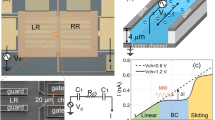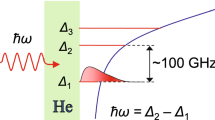Abstract
We propose a frequency-mixed effect of terahertz (THz) and gigahertz (GHz) electromagnetic waves in the cryogenic system of electrons floating on liquid helium surface. The THz wave is near-resonant with the transition frequency between the lowest two levels of surface state electrons. The GHz wave does not excite the transitions but generates a GHz-varying Stark effect with the symmetry-breaking eigenstates of electrons on liquid helium. We show an effective coupling between the inputting THz and GHz waves, which appears at the critical point that the detuning between electrons and THz wave is equal to the frequency of GHz wave. By this coupling, the THz and GHz waves cooperatively excite electrons and generate the low-frequency ac currents along the perpendicular direction of liquid helium surface to be experimentally detected by the image-charge approach (Phys Rev Lett 123:086801, 2019). This offers an alternative approach for THz detections.



Similar content being viewed by others
Data Availability Statement
The data generated or analyzed during this study are included in this published article.
References
P.M. Platzman, M.I. Dykman, Quantum computing with electrons floating on liquid helium. Science 284, 1967 (1999). https://doi.org/10.1126/science.284.5422.1967
G. Yang, A. Fragner, G. Koolstra, L. Ocola, D.A. Czaplewski, R.J. Schoelkopf, D.I. Schuster, Coupling an ensemble of electrons on superfluid helium to a superconducting circuit. Phys. Rev. X 6, 011031 (2016). https://doi.org/10.1103/PhysRevX.6.011031
E. Collin, W. Bailey, P. Fozooni, P.G. Frayne, P. Glasson, K. Harrabi, M.J. Lea, G. Papageorgiou, Microwave saturation of the Rydberg states of electrons on helium. Phys. Rev. Lett. 89, 245301 (2002). https://doi.org/10.1103/PhysRevLett.89.245301
M.I. Dykman, P.M. Platzman, P. Seddighrad, Qubits with electrons on liquid helium. Phys. Rev. B 67, 155402 (2003). https://doi.org/10.1103/PhysRevB.67.155402
F.R. Bradbury, M. Takita, T.M. Gurrieri, K.J. Wilkel, K. Eng, M.S. Carroll, S.A. Lyon, Efficient clocked electron transfer on superfluid helium. Phys. Rev. Lett. 107, 266803 (2011). https://doi.org/10.1103/PhysRevLett.107.266803
S. Mostame, R. Schützhold, Quantum simulator for the Ising model with electrons floating on a helium film. Phys. Rev. Lett. 101, 220501 (2008). https://doi.org/10.1103/PhysRevLett.101.220501
D.I. Schuster, A. Fragner, M.I. Dykman, S.A. Lyon, R.J. Schoelkopf, Proposal for manipulating and detecting spin and orbital states of trapped electrons on helium using cavity quantum electrodynamics. Phys. Rev. Lett. 105, 040503 (2010). https://doi.org/10.1103/PhysRevLett.105.040503
Y. Monarkha, D. Konstantinov, Magneto-oscillations and anomalous current states in a photoexcited electron gas on liquid helium. J. Low Temp. Phys. 197, 208 (2019). https://doi.org/10.1007/s10909-019-02210-w
A.O. Badrutdinov, D.G. Rees, J.Y. Lin, A.V. Smorodin, D. Konstantinov, Unidirectional charge transport via ripplonic polarons in a three-terminal microchannel device. Phys. Rev. Lett. 124, 126803 (2020). https://doi.org/10.1103/PhysRevLett.124.126803
S.A. Lyon, Spin-based quantum computing using electrons on liquid helium. Phys. Rev. A 74, 052338 (2006). https://doi.org/10.1103/PhysRevA.74.052338
M. Zhang, L.F. Wei, Spin-orbit couplings between distant electrons trapped individually on liquid helium. Phys. Rev. B 86, 205408 (2012). https://doi.org/10.1103/PhysRevB.86.205408
W.T. Sommer, Liquid helium as a barrier to electrons. Phys. Rev. Lett. 12, 271 (1964). https://doi.org/10.1103/PhysRevLett.12.271
M.W. Cole, Electronic surface states of liquid helium. Rev. Mod. Phys. 46, 451 (1974). https://doi.org/10.1103/RevModPhys.46.451
C.C. Grimes, T.R. Brown, Direct spectroscopic observation of electrons in image-potential states outside liquid helium. Phys. Rev. Lett. 32, 280 (1974). https://doi.org/10.1103/PhysRevLett.32.280
C.C. Grimes, T.R. Brown, M.L. Burns, C.L. Zipfel, Spectroscopy of electrons in image-potential-induced surface states outside liquid helium. Phys. Rev. B 13, 140 (1976). https://doi.org/10.1103/PhysRevB.13.140
E. Kawakami, A. Elarabi, D. Konstantinov, Image-charge detection of the Rydberg states of surface electrons on liquid helium. Phys. Rev. Lett. 123, 086801 (2019). https://doi.org/10.1103/PhysRevLett.123.086801
A. Elarabi, E. Kawakami, D. Konstantinov, Cryogenic amplification of image-charge detection for readout of quantum states of electrons on liquid helium. J. Low Temp. Phys. 202, 456 (2021). https://doi.org/10.1007/s10909-020-02552-w
E. Kawakami, A. Elarabi, D. Konstantinov, Relaxation of the excited Rydberg states of surface electrons on liquid helium. Phys. Rev. Lett. 126, 106802 (2021). https://doi.org/10.1103/PhysRevLett.126.106802
M. Tonouchi, Cutting-edge terahertz technology. Nat. Photon. 1, 97 (2007). https://doi.org/10.1038/nphoton.2007.3
K. Huang, Z. Wang, Terahertz terabit wireless communication. IEEE Microw. Mag. 12, 108 (2011). https://doi.org/10.1109/MMM.2011.940596
L. Sabbatini, L. Pizzo, G. Dall’Oglio, The brightness temperature of Mercury at 150 and 240 GHz. Eur. Phys. J. Plus. 126, 99 (2011). https://doi.org/10.1140/epjp/i2011-11099-3
J.S. Melinger, Y. Yang, M. Mandehgar, D. Grischkowsky, THz detection of small molecule vapors in the atmospheric transmission windows. Opt. Express 20, 6788 (2012). https://doi.org/10.1364/OE.20.006788
S. Khushbu, M. Yashini, R. Ashish, C.K. Sunil, Recent advances in Terahertz time-domain spectroscopy and imaging techniques for automation in agriculture and food sector. Food Anal Methods 15, 498 (2022). https://doi.org/10.1007/s12161-021-02132-y
P.H. Siegel, Terahertz technology in biology and medicine. IEEE Trans. Microw. Theory Tech. 52, 2438 (2004). https://doi.org/10.1109/TMTT.2004.835916
M. Nagel, P. Haring Bolivar, M. Brucherseifer, H. Kurz, A. Bosserhoff, R. B\(\ddot{\rm {u}}\)ttner, Integrated THz technology for label-free genetic diagnostics. Appl. Phys. Lett. 80, 154 (2002). https://doi.org/10.1063/1.1428619
M. Jing, Y. Hu, J. Ma, H. Zhang, L.J. Zhang, L.T. Xiao, S.T. Jia, Atomic superheterodyne receiver based on microwave-dressed Rydberg spectroscopy. Nat. Phys. 16, 911 (2020). https://doi.org/10.1038/s41567-020-0918-5
M.M. Nieto, Electrons above a helium surface and the one-dimensional Rydberg atom. Phys. Rev. A 61, 034901 (2000). https://doi.org/10.1103/PhysRevA.61.034901
M. Zhang, H.Y. Jia, L.F. Wei, Jaynes-Cummings models with trapped electrons on liquid helium. Phys. Rev. A 80, 055801 (2009). https://doi.org/10.1103/PhysRevA.80.055801
M. Fleischhauer, A. Imamoglu, J.P. Marangos, Electromagnetically induced transparency: optics in coherent media. Rev. Mod. Phys. 77, 633 (2005). https://doi.org/10.1103/RevModPhys.77.633
M. Zhang, W.Z. Jia, L.F. Wei, Frequency-doubled scattering of symmetry-breaking surface-state electrons on liquid helium. Physica B Condens. Matter 432, 12 (2014). https://doi.org/10.1016/j.physb.2013.09.026
Acknowledgements
This work was supported by the National Natural Science Foundation of China, Grants No. 12047576, and No. 11974290.
Author information
Authors and Affiliations
Corresponding author
Rights and permissions
About this article
Cite this article
Wang, T., Zhang, M. & Wei, L.F. Electric current induced by microwave Stark effect of electrons on liquid helium. Eur. Phys. J. Plus 137, 688 (2022). https://doi.org/10.1140/epjp/s13360-022-02852-y
Received:
Accepted:
Published:
DOI: https://doi.org/10.1140/epjp/s13360-022-02852-y




